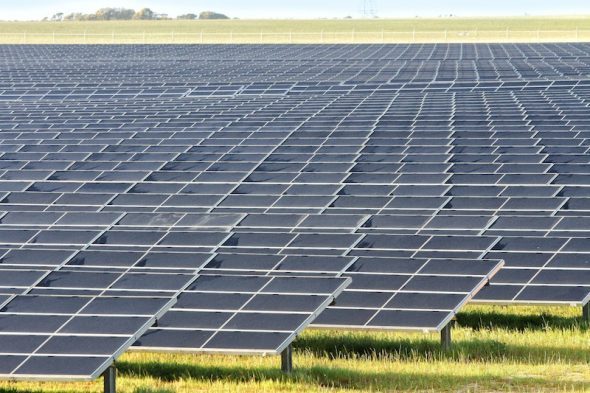To borrow an old saying, if you have seen one panel you have seen them all. In the case of the Greenough River solar farm, this seems to be quite true.
There are 150,000 of them spread over 80 hectares of private land, about 50kms south-east of Geraldton, in one of the richest solar regions in the country. And the panels all seem perfectly identical – all 60cm by 20cm, black, mounted in Geelong and trucked over to WA, and installed at a 25 degree angle. They all face north.
Dotted amid the field of panels are 16 small buildings, each housing 720kW inverter systems supplied by German group SMA that converts the electricity generated by the solar cells from direct current into alternating current so it’s compatible with the grid.
Australia now sports a rooftop array on one out of every 10 households. As Ray Wills points out today, there is as much, or even more, rooftop capacity as this farm spread across rooftops in localities such as Mandurah. But Australia has never seen anything like this, row upon row of panels stuck in the middle of the paddock. The question is: how much more will we see it?
One energy industry executive quipped the other day that it was not so long ago that solar was regarded as tax on people who couldn’t do math. In the case of rooftop solar, that is certainly no longer the case, because it can clearly compete with the cost of electrons at the socket.
Utility-scale solar has a more challenging task – it has to match the cost of coal-fired generation, or at least the price that prevails through daytime hours, which tends to be higher than that in the evening.
For First Solar, which accounts for more than half of the utility-scale solar farms being built, this is the first time it has acted as the main EPC contractor outside of North America. It has placed its future on being a vertically integrated company, rather than just a module manufacturer, which CFO Mark Widmar says – pointing to the experience of the Chinese manufacturing market in particular – is merely a commodity.
One of the remarkable things about the Greenough River project is that site work only commenced last November, with the first panels installed in April. It has been operating at pretty much full capacity for the last two months. And the results have been good – it now stands to produce 20GW in its first year, a capacity factor of 26 per cent. “Only in Chile will you get better solar resources,” says Jack Curtis, vice president, business development and sales.
Such excellent solar resources means that Curtis is confident that the cost of utility-scale solar PV will fall to between $100-$140/MWh by 2016. That means it will be competitive with wind, because Curtis says utilities will be willing to pay $10-$40/MWh premium for solar PV over wind energy, because it can deliver predictable power during the day, which will command premium rates. Curtis says the experience so far from Greenough River shows a solid bell curve of delivered electricity, but most important predictability for the network operators.
If those cost metrics can be met, the fact that solar PV farms can be installed relatively quickly, do not attract the controversy of wind power, and will be supported by banks, means that solar PV could be displacing wind projects by 2016. That means a big fight for the market created by the renewable energy target, presuming it remains untouched. Curtis believes that solar PV could deliver between 3,000 and 5,000MW of utility-scale capacity by 2020. That’s a lot of panels.








